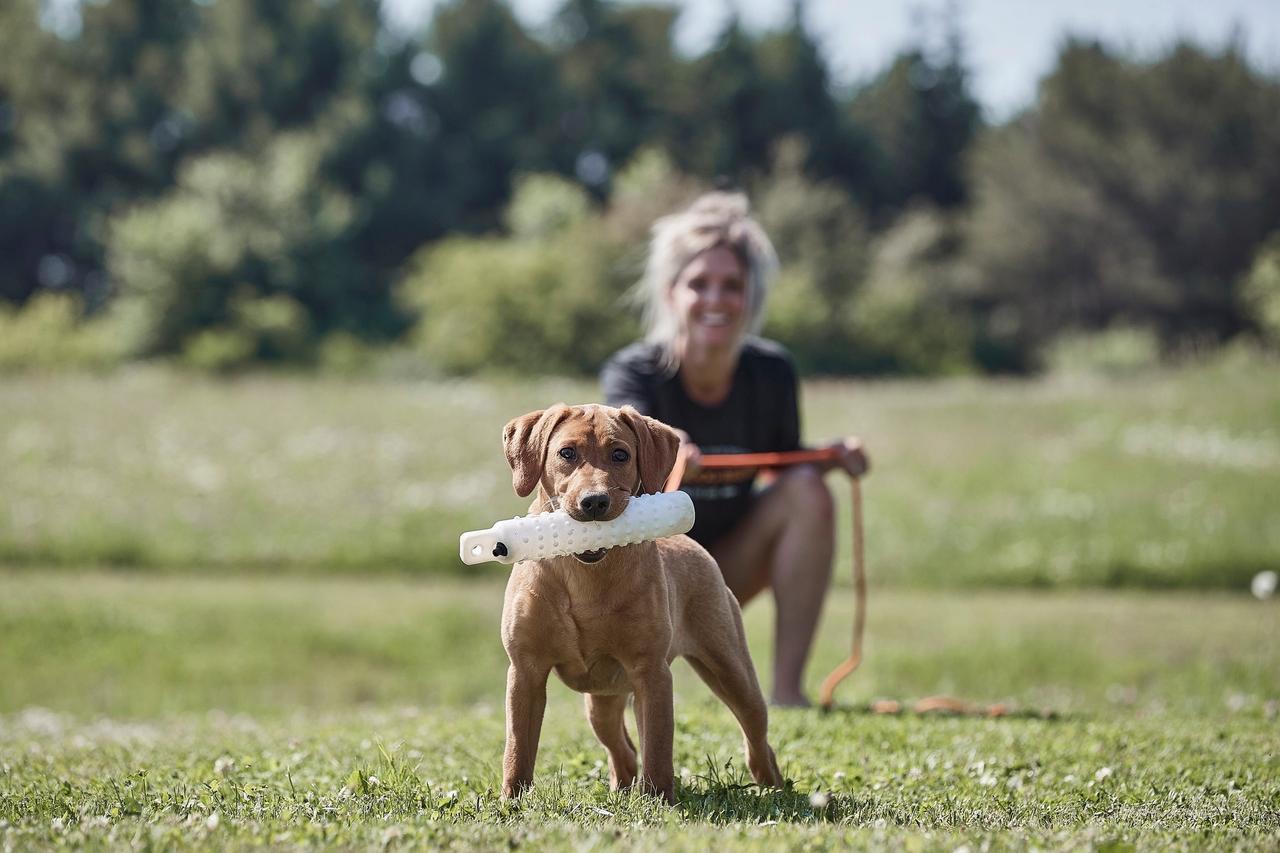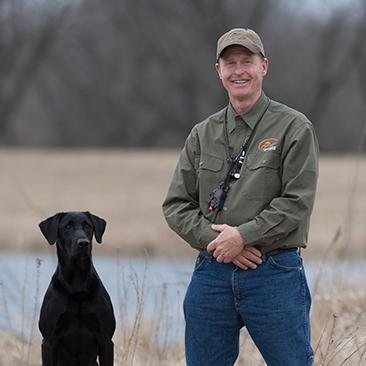
Tout sur les mannequins d'entraînement pour retrievers
Publié par Tom DokkenLes mannequins d'entraînement sont un élément essentiel d'un bon programme de formation pour les chiens rapporteurs. Que vous les appeliez mannequins ou pare-chocs n'a pas d'importance, mais ce qui compte, c'est de choisir le bon style et la bonne couleur pour s'adapter à vos situations d'entraînement.
Les mannequins sont disponibles en grande ou petite taille et en plastique ou en toile. Ils sont également disponibles dans une variété de couleurs, les principales étant le blanc, le noir, le noir et blanc, et l'orange.
À première vue, on pourrait penser qu'il n'y a pas beaucoup de considérations à prendre en compte lors du choix d'un mannequin d'entraînement. Après tout, tout retriever digne de ce nom pense que poursuivre et rapporter à peu près n'importe quel objet est le summum du plaisir pour un chien. Cependant, bien que cela puisse être vrai, vos séances d'entraînement bénéficieront d'une certaine réflexion préalable concernant l'utilisation et la sélection des mannequins.
Contraste, contraste, contraste !
La première règle pour mettre en place des exercices de rapport ou de « marquage » valables est de donner à votre chien toutes les chances de voir le lancer. Sinon, quel est l'intérêt ?
Tenez toujours compte de l'arrière-plan et essayez d'imaginer comment votre chien va percevoir le lancer lorsque vous mettez en place des exercices de marquage. Si vous lancez contre un fond sombre comme une ligne d'arbres, vous devriez évidemment utiliser du blanc. Si le lancer doit amener le leurre contre un ciel lumineux en plein midi, un leurre noir/blanc devrait offrir ce contraste tant nécessaire qui aidera votre chien à le voir clairement.
Gardez à l'esprit le facteur de contraste tout-important et vous ne pouvez pas vous tromper. Lorsque vous travaillez à renforcer la confiance d'un chien, le blanc sera presque toujours privilégié car votre chien n'aura pas à fournir beaucoup d'effort pour trouver le leurre lorsqu'il s'en approche. En ce qui concerne l'entraînement dans l'eau, rien ne surpasse la manière dont un leurre blanc scintille pratiquement sur l'eau si vous faites courir votre chien avec le soleil derrière vous. Cela peut être un grand motivateur lorsque vous travaillez sur des rapports plus longs.
Beaucoup de gens ne comprennent pas pourquoi leur chien ne peut pas facilement voir un leurre orange, même dans l'herbe courte. C'est parce que pour les yeux d'un chien, un leurre orange apparaît gris et se fond donc dans la plupart des couvertures au sol. L'orange est excellent pendant l'entraînement pour les récupérations à l'aveugle lorsque vous voulez être sûr que votre chien ne peut pas voir l'objet que vous lui avez envoyé chercher. Mais je devrais aussi ajouter que l'orange a sa place dans les exercices de marquage. Il semble offrir beaucoup de contraste lorsqu'il est lancé contre un ciel lumineux, et dans cette situation, il peut même ressortir mieux que le blanc.
Adapter la taille du mannequin au chien
Il est important de commencer avec un mannequin de petit diamètre pendant l'entraînement des chiots. Vous voulez encourager votre chiot à le saisir par le milieu. Lorsqu'un mannequin est trop grand pour qu'un chien puisse le porter confortablement, il aura tendance à le saisir par la corde de lancement ou sur la partie étroite près de l'œillet, et cela peut conduire à de mauvaises habitudes qui deviennent difficiles à corriger.
En ce qui concerne la corde de lancer, je suggère de ne pas l'attacher aux mannequins de la taille d'un chiot dans les premières étapes de l'entraînement. C'est une variable de moins à gérer.
Un facteur que je pense est souvent négligé à mesure qu'un chien grandit, c'est qu'il faut s'assurer qu'il s'habitue régulièrement à manipuler un plus gros leurre. Qu'il soit en plastique ou en toile, un leurre plus gros qui remplit mieux la gueule du chien signifie moins de chances qu'il puisse le faire bouger dans sa bouche et le mâcher, ce qui peut conduire à une gueule dure. De plus, les gibiers à plumes tels que les canards et les faisans sont assez gros, donc c'est un excellent exemple où vous voulez suivre l'axiome « s'entraîner comme vous voulez jouer » pendant l'entraînement.
Toile ou plastique ?
La plupart des dresseurs se rendent sur le terrain bien équipés de mannequins à la fois en plastique et recouverts de toile. Le plastique convient pour à peu près toutes les situations. En ce qui concerne le contraste des couleurs, toutes les considérations mentionnées précédemment s'appliquent à chaque type. La toile, cependant, offre une certaine polyvalence car elle ressemble davantage à un vrai oiseau. Laissez-moi expliquer.
Il est important de s'entraîner avec de vrais oiseaux lorsque c'est possible, mais soyons réalistes ; les canards et les faisans vivants ou fraîchement tués ne sont pas toujours disponibles et peuvent devenir coûteux. Un grand mannequin en toile peut combler ce manque. Une paire d'ailes de canard ou de faisan fixées à un mannequin en toile avec du ruban isolant crée un objet volumineux et lourd, et les ailes ajoutent une texture de vrai oiseau. Au total, le résultat est une dose supplémentaire d'excitation pendant les exercices d'entraînement.
Un avantage supplémentaire des mannequins en toile est qu'ils vous permettront de savoir si votre chien développe un problème de mastication. Si vos mannequins en toile sont pleins de marques de dents profondes ou si vous voyez que votre chien perce la toile, il n'est pas difficile d'imaginer ce qui se passera avec de vrais oiseaux. Si vous constatez des preuves que la mâchoire dure devient un problème, il est temps de consulter un dresseur professionnel qui pourra revoir l'apprentissage de la force de rapport et trouver une solution.
Considérations sur les parfums
Bien que l'accent soit mis sur l'aspect crucial du marquage des lancers avec les mannequins d'entraînement, il arrive des moments où vous pourriez vouloir travailler sur des exercices liés à l'odorat. Encore une fois, rien ne vaut de vrais oiseaux, mais un mannequin contenant l'odeur d'un oiseau peut faire un substitut convenable.
Si vous souhaitez donner à votre chien un avantage pour utiliser son nez afin de trouver des leurres en plastique, appliquez-lui une odeur à base de cire commerciale. Je préfère la cire à l'odeur liquide car la cire retiendra l'odeur plus longtemps et nécessitera donc moins de rafraîchissement.
Les mannequins en toile sont excellents pour absorber et retenir l'odeur liquide. Si vous travaillez sur des exercices de pistage (pour l'entraînement à la chasse au faisan par exemple), un mannequin en toile imprégné d'odeur liquide et traîné à travers un couvert léger devrait donner au chien beaucoup de travail.
Un mannequin de rapport est aussi simple à utiliser qu'il est précieux. Réfléchir aux styles, tailles et couleurs que vous utilisez vous aidera à former un rapporteur plus performant.

Tom Dokken
Northfield, MN
Dokken apporte plus de 45 ans d'expérience dans l'entraînement de retrievers à l'équipe SportDOG. Il est bien connu en tant qu'inventeur du Dokken’s Deadfowl Trainer, qui est devenu un équipement standard pour les dresseurs de retrievers partout. Il est le propriétaire de Dokken Dog Supply et des chenils Dokken’s Oak Ridge, le plus grand centre de dressage de chiens de chasse...
